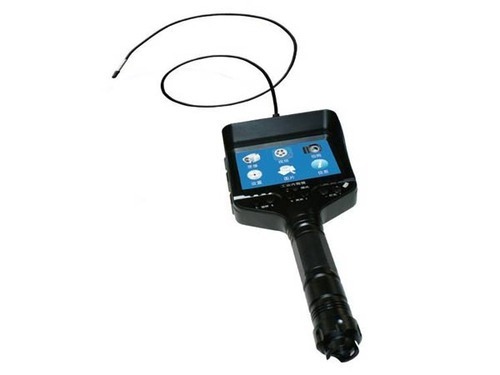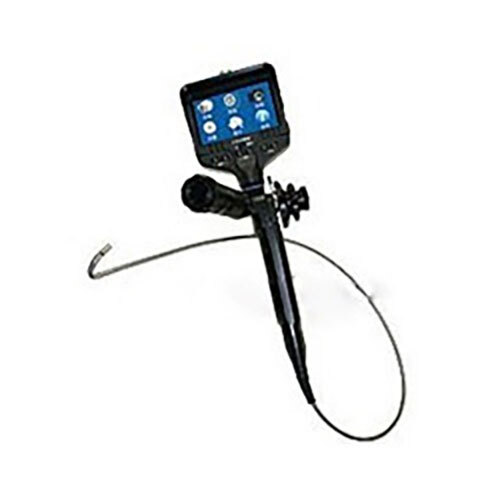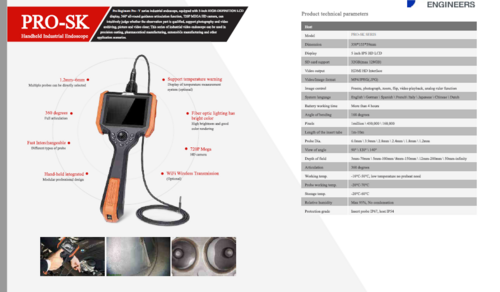Video Pipeline Endoscope
10000 INR/Unit
Product Details:
- Usage Measuring Tools
- Application Industrial
- Color Black
- Material Mild Steel
- Temperature -10 to -50 Celsius (oC)
- Product Type Video Pipeline Endoscope
- Power Supply Battery
- Click to View more
X
Video Pipeline Endoscope Price And Quantity
- 1 , , Unit
- 10000 INR/Unit
Video Pipeline Endoscope Product Specifications
- Battery
- Video Pipeline Endoscope
- Mild Steel
- -10 to -50 Celsius (oC)
- Industrial
- Black
- Measuring Tools
Video Pipeline Endoscope Trade Information
- 100 , , Unit Per Week
- 1 Week
- All India
Product Description
A video pipeline endoscope is a specialized medical device used for diagnostic and therapeutic procedures in various medical fields, particularly in gastroenterology, pulmonology, and urology. It consists of a flexible tube with a camera and light source at its tip, allowing physicians to visualize internal organs and structures.
Other Details:
- Standard Configuration: Z-8 Endoscope
- 5 Inch screen & high resolution of TFT-LCD 1
- Li Rechargeable Batteries 2
- AC adapter 1 USB Cable 1 Plastic Tool Case 1 Manual
- Mainly use for rapid diagnosis of welding quality, surface smoothness, corrosion, cracks, blockage and collapse, together with surface measurement and foreign objects retrieval
- This is especially suitable for small pipes
- Rechargeable-ion battery can last 7-8 hours
- Resolution of screen 800*480 Cable is plastic molding tube with flexible angles
- Probe diameter: 8 mm
- Cable Length: 1 m, 1-30 m is optional
- Camera Direction: Front View (Optional prism)
- Visual Angle: 95 Degree
- Focus: 10 mm-100 mm
- Lighting: Adjustable LED light for 0.5 meter irradiation
- Camera: 300000 Pixels
- Photographing and Video: Available
- Memory Capacity: 4G
- Waterproof: IP65
- Working Temperature: -10 Degree-50 Degree
Here's how it typically works:
1. Insertion: The endoscope is inserted into the body through a natural opening or a small incision.
2. Visualization: The camera at the tip of the endoscope captures high-definition video images of the internal structures. These images are transmitted in real-time to a monitor, allowing the physician to see detailed views of the area being examined.
3. Navigation: The flexible nature of the endoscope allows it to navigate through the body's various twists and turns, reaching deep into organs or cavities that are otherwise difficult to access.
4. Diagnostic and Therapeutic Procedures: During the examination, the physician may perform various diagnostic procedures such as biopsies, tissue sampling, or removal of foreign objects. Additionally, therapeutic procedures like polyp removal, cauterization of bleeding vessels, or stent placement can also be carried out using specialized tools inserted through channels in the endoscope.
5. Documentation: The video feed from the endoscope can be recorded for documentation purposes or for further review by other healthcare professionals.
Video pipeline endoscopes have revolutionized the field of minimally invasive surgery and have significantly improved diagnostic accuracy and patient outcomes. They allow physicians to visualize and treat internal conditions without the need for extensive incisions, leading to faster recovery times and reduced risk of complications for patients.
Video Pipeline Endoscope Specifications:
1. Power Source: Battery
2. Brand: Pro
3. Material: Mild Steel
4. Resolution: 300000 Pixels
5. Model Name/Number: PRO-UR-VT-Z
6. Working Temperature: -10 to -50 Degree
Video Pipeline Endoscope FAQ:
Q. What is a video pipeline endoscope?
Ans: A video pipeline endoscope is a medical device used to visualize and access internal organs or cavities in the body. It consists of a flexible tube with a camera and light source at its tip, allowing real-time video imaging.
Q. What medical procedures are video pipeline endoscopes used for?
Ans: Video pipeline endoscopes are used for diagnostic and therapeutic procedures in various medical fields, including gastroenterology (for examining the digestive tract), pulmonology (for examining the lungs and airways), urology (for examining the urinary tract), and other specialties.
Q. How is a video pipeline endoscope inserted into the body?
Ans: The endoscope is typically inserted through a natural opening in the body, such as the mouth (for upper gastrointestinal procedures), anus (for lower gastrointestinal procedures), or urethra (for urological procedures). In some cases, a small incision may be made to insert the endoscope.
Q. What are the benefits of using a video pipeline endoscope?
Ans: The benefits include minimally invasive access to internal structures, real-time visualization of tissues, the ability to perform diagnostic and therapeutic procedures simultaneously, reduced risk of complications compared to traditional surgery, and faster recovery times for patients.
Q. Are there any risks associated with using a video pipeline endoscope?
Ans: While video pipeline endoscopes are generally safe, there are risks such as bleeding, infection, perforation of tissues, or adverse reactions to sedation or anesthesia. These risks are typically low and are outweighed by the benefits of the procedure.
Q. How long does a video pipeline endoscopy procedure take?
Ans: The duration of the procedure depends on the specific type of endoscopy and the complexity of the case. Generally, it can take anywhere from 15 minutes to an hour or longer, depending on the findings and any necessary interventions.
Q. Is sedation or anesthesia required for a video pipeline endoscopy?
Ans: Sedation or anesthesia may be used to ensure patient comfort during the procedure, especially for more invasive or uncomfortable examinations. The type and level of sedation will depend on factors such as the patient's medical condition and the nature of the procedure.
Q. Can video footage from the endoscope be saved for future reference?
Ans: Yes, the video feed from the endoscope can be recorded and saved for documentation purposes or for further review by healthcare professionals. This allows for accurate documentation of findings and facilitates collaboration between healthcare providers.
Q. How often are video pipeline endoscopes cleaned and sterilized?
Ans: Video pipeline endoscopes are cleaned and sterilized according to strict protocols recommended by regulatory agencies and professional organizations. This typically involves thorough cleaning, disinfection, and high-level sterilization after each use to prevent the transmission of infections between patients.
Q. Are there any alternatives to video pipeline endoscopes?
Ans: Traditional endoscopes without video capabilities may be used in some cases, but they lack the real-time visualization provided by video endoscopes. Other imaging modalities such as X-rays, CT scans, or MRI scans may also be used for certain diagnostic purposes, but they may not offer the same level of detail or access to internal structures as endoscopy.
Precision in Testing & Measurement
Engineered specifically for industrial applications, our video pipeline endoscope ensures accurate and reliable measurements in confined or hard-to-access spaces. Its robust design and advanced optics make it a practical choice for technicians requiring precise inspection and diagnostic capabilities.
Versatile Power Options
The endoscope can be powered by both DC currents and batteries, providing flexibility for extended usage in remote locations. This feature ensures uninterrupted operation during critical testing procedures, making it a dependable tool for industrial professionals.
FAQs of Video Pipeline Endoscope:
Q: How do I operate the video pipeline endoscope for measurement purposes?
A: To use the endoscope for measuring, insert the probe into the pipeline or desired area. The camera captures real-time video, allowing you to observe and measure internal structure details with accuracy. Follow the user manual to calibrate any measuring tools provided.Q: What are the benefits of using this endoscope in industrial environments?
A: This endoscopes durable mild steel construction and wide temperature tolerance (-10 to -50C) make it suitable for harsh industrial conditions. Its high-quality video capabilities enable thorough inspections, reducing maintenance costs and operational downtime.Q: When is the ideal time to use this video pipeline endoscope?
A: This equipment is best utilized during scheduled maintenance, routine inspections, or troubleshooting processes where internal visibility is limited. Its temperature resilience allows for use in both standard and extreme industrial climates.Q: Where can this endoscope be used within industrial settings?
A: It is well-suited for pipelines, machinery, storage tanks, and other inaccessible or narrow spaces. It is widely employed by exporters, manufacturers, service providers, suppliers, and traders throughout India.Q: What is the process for powering the endoscope during field use?
A: The endoscope supports both DC and battery operation. For continuous use, connect it to a DC power supply; for mobile or remote work, insert compatible batteries for cordless functionality.Q: How does the material and build quality benefit long-term use?
A: Manufactured with mild steel, the endoscope offers exceptional durability and corrosion resistance, ensuring prolonged lifespan even in challenging industrial applications.Tell us about your requirement

Price:
Quantity
Select Unit
- 50
- 100
- 200
- 250
- 500
- 1000+
Additional detail
Mobile number
Email
 English
English Spanish
Spanish French
French German
German Italian
Italian Chinese (Simplified)
Chinese (Simplified) Japanese
Japanese Korean
Korean Arabic
Arabic Portuguese
Portuguese






 Call Me Free
Call Me Free
